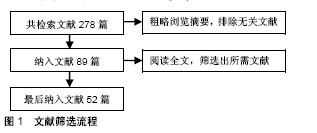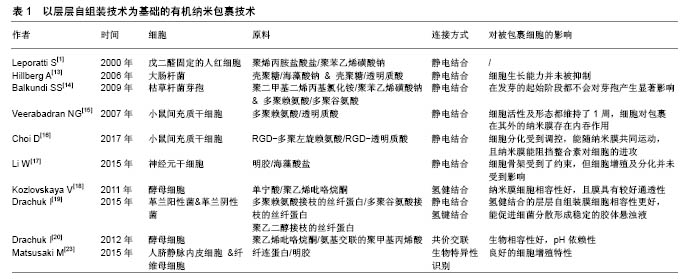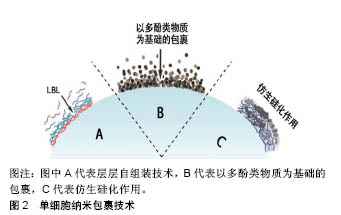| [1] Leporatti S, Voigt A, Möhwald R, et al. Scanning force microscopy investigation of polyelectrolyte nano- and microcapsule wall texture. Langmuir. 2000;16(9):4059-4063. [2] Diaspro A, Silvano D, Krol S, et al. Single living cell encapsulation in nano-organized polyelectrolyte shells. Langmuir. 2002;18(13): 5047-5050. [3] Ai H, Fang M, Jones SA, et al. Electrostatic layer-by-layer nanoassembly on biological microtemplates: platelets. Biomacromolecules. 2002;3(3):560-564. [4] Fakhrullin RF, Lvov YM. “Face-lifting”and “make-Up”for microorganisms: layer-by-layer polyelectrolyte nanocoating. ACS Nano. 2012;6(6):4557-4564. [5] Drachuk I, Gupta MK, Tsukruk VV. Biomimetic Coatings to Control Cellular Function through Cell Surface Engineering. Adv Funct Mater. 2013;23(36):4437-4453. [6] 张仲达,杨文芳.层层自组装聚电解质微胶囊的性能调控及其应用研究[J].材料导报,2017,31(3):40-45.[7] Kadowaki K, Matsusaki M, Akashi M. Control of Cell Surface and Functions by Layer-by-Layer Nanofilms. Langmuir. 2010;26(8): 5670-5678. [8] Martinez JS, Keller TCS 3rd, Schlenoff JB. Cytotoxicity of Free versus Multilayered Polyelectrolytes. Biomacromolecules. 2011;12(11): 4063-4079. [9] Zhang H, Chang H, Wang LM, et al. Effect of Polyelectrolyte Film Stiffness on Endothelial Cells During Endothelial-to-Mesenchymal Transition. Biomacromolecules. 2015;16(11):3584-3593. [10] Matsusaki M, Kadowaki K, Nakahara Y, et al. Fabrication of cellular multilayers with nanometer-sized extracellular matrix films. Angew Chem. 2007;119:4773-4776. [11] Donath E, Moya S, Neu B, et al. Hollow polymer shells from biological templates: Fabrication and potential applications. Chem Eur J. 2002; 8(23):5481-5485. [12] Neu B, Voigt A, Mitlöhner R, et al. Biological cells as templates for hollow microcapsules. J Microencapsul. 2001;18(3):385-395. [13] Hillberg A, Tabrizian M. Biorecognition through layer-by-layer polyelectrolyte assembly: In-situ hybridization on living cells. Biomacromolecules. 2006;7(10):2742-2750. [14] Balkundi SS, Veerabadran NG, Eby DM, et al. Encapsulation of Bacterial Spores in Nanoorganized Polyelectrolyte Shells. Langmuir. 2009;25(24):14011-14016. [15] Veerabadran NG, Goli PL, Stewart-Clark SS, et al. Nanoencapsulation of stem cells within polyelectrolyte multilayer shells. Macromol Biosci. 2007;7(7):877-882. [16] Choi D, Lee H, Kim HB, et al. Cytoprotective Self-assembled RGD Peptide Nanofilms for Surface Modification of Viable Mesenchymal Stem Cells. Chem Mater. 2017;29(5):2055-2065. [17] Li W, Guan T, Zhang X, et al. The Effect of Layer-by-Layer Assembly Coating on the Proliferation and Differentiation of Neural Stem Cells. ACS Appl Mater Interfaces. 2015;7(5):3018-3029. [18] Kozlovskaya V, Harbaugh S, Irina D, et al. Hydrogen-bonded LbL shells for living cell surface engineerin. Soft Matter. 2011;7(6): 2363-2372. [19] Drachuk I, Calabrese R, Harbaugh S, et al. Silk macromolecules with amino acid-poly(ethylene glycol) grafts for controlling layer-by-layer encapsulation and aggregation of recombinant bacterial cells. ACS Nano. 2015;9(2):1219-1235. [20] Drachuk I, Shchepelina O, Lisunova M, et al. pH-Responsive Layer-by-Layer Nanoshells for Direct Regulation of Cell Activity. ACS Nano. 2012;6(5):4266-4278. [21] Michiya M, Hiroharu A, Toshiyuki K. Layer-by-Layer Assembly Through Weak Interactions and Their Biomedical Applications. Adv Mater. 2012;24(4):454-474. [22] Matsuzawa A, Matsusaki M, Akashi M. Effectiveness of nanometer- sized extracellular matrix layer-by-layer assembled films for a cell membrane coating protecting cells from physical stress. Langmuir. 2013;29(24):7362-7368. [23] Matsusaki M, Fujimoto K, Shirakata Y, et al. Development of full-thickness human skin equivalents with blood and lymph-like capillary networks by cell coating technology. J Biomed Mater Res Part A. 2015;103(10):3386-3396. [24] Ejima H, Richardson JJ, Liang K, et al. One-step assembly of coordination complexes for versatile film and particle engineering. Science. 2013;341(6142):154-157. [25] Guo JL, Ping Y, Ejima H, et al. Engineering multifunctional capsules through the assembly of metal-phenolic networks. Angew Chem Int Ed. 2014;53(22):5546-5551. [26] Kim S, Kim DS, Kang SM. Reversible layer-by-layer deposition on solid substrates inspired by mussel byssus cuticle. Chem Asian J. 2014;9(1):63-66. [27] Harrington MJ, Masic A, Holten-Andersen N, et al. Iron-clad fibers: a metal-based biological strategy for hard flexible coatings. Science. 2010;328(5975):216-220. [28] Park JH, Kim K, Lee J, et al. A cytoprotective and degradable metal-polyphenol nanoshell for single-cell encapsulation. Angew Chem Int Ed. 2014;53(46):12420-12425. [29] Lee J, Cho H, Choi J, et al. Chemical sporulation and germination: cytoprotective nanocoating of individual mammalian cells with a degradable tannic acid-Fe-III complex. Nanoscale. 2015;7(45): 18918-18922. [30] Li W, Bing W, Huang S, et al. Mussel Byssus-Like Reversible Metal-Chelated Supramolecular Complex Used for Dynamic Cellular Surface Engineering and Imaging. Adv Funct Mater. 2015;25(24): 3775-3784. [31] Park T, Kim JY, Cho H, et al. Artificial Spores: Immunoprotective Nanocoating of Red Blood Cells with Supramolecular Ferric Ion-Tannic Acid Complex. Polymers. 2017;9(4). [32] Park JH, Choi S, Moon HC, et al. Antimicrobial spray nanocoating of supramolecular Fe(III)-tannic acid metal-organic coordination complex: applications to shoe insoles and fruits. Sci Rep. 2017;7:6980-6987. [33] Lee H, Dellatore SM, Miller WM, et al. Mussel-inspired surface chemistry for multifunctional coatings. Science. 2007;318(5849): 426-430. [34] Wang B, Wang G, Zhao B, et al. Antigenically shielded universal red blood cells by polydopamine-based cell surface engineering. Chem Sci. 2014;5(9):3463-3468. [35] Kim BJ, Park T, Moon HC, et al. Cytoprotective Alginate/Polydopamine Core/Shell Microcapsules in Microbial Encapsulation. Angew Chem Int Ed. 2014;53(52):14443-14446. [36] Kim BJ, Park T, Park SY, et al. Control of Microbial Growth in Alginate/Polydopamine Core/Shell Microbeads. Chem Asian J. 2015; 10(10):2130-2133. [37] Zheng W, Gao J, Song L, et al. Surface-Induced Hydrogelation Inhibits Platelet Aggregation. J Am Chem Soc. 2013;135(1):266-271. [38] Liang K, Richardson JJ, Cui J, et al. Metal-Organic Framework Coatings as Cytoprotective Exoskeletons for Living Cells. Adv Mater. 2016;28(36):7910-7914. [39] Doonan C, Riccò R, Liang K, et al. Metal-Organic Frameworks at the Biointerface: Synthetic Strategies and Applications. Acc Chem Res. 2017;50(6):1423-1432. [40] Liang K, Carbonell C, Styles MJ, et al. Biomimetic Replication of Microscopic Metal-Organic Framework Patterns Using Printed Protein Patterns. Adv Mater. 2015;27(45):7293-7298. [41] Liang K, Ricco R, Doherty MC, et al. Biomimetic mineralization of metal-organic frameworks as protective coatings for biomacromolecules. Nat Commun. 2015;6(7240):1-8. [42] Yang SH, Lee KB, Kong B, et al. Biomimetic Encapsulation of Individual Cells with Silica. Angew Chem Int Ed. 2009;48(48): 9160-9163. [43] Roth KM, Zhou Y, Yang W, et al. Bifunctional small molecules are biomimetic catalysts for silica synthesis at neutral pH. J Am Chem Soc. 2005;127(1):325-330. [44] Lee J, Choi J, Park JH, et al. Cytoprotective Silica Coating of Individual Mammalian Cells through Bioinspired Silicification. Angew Chem Int Ed. 2014;53(31):8056-8059. [45] Yang SH, Ko EH, Choi IS. Cytocompatible encapsulation of individual Chlorella cells within titanium dioxide shells by a designed catalytic peptide. Langmuir. 2012;28(4):2151-2155. [46] Fakhrullin RF, Minullina RT. Hybrid cellular-inorganic core-shell microparticles: encapsulation of individual living cells in calcium carbonate microshells. Langmuir. 2009;25(12):6617-6621[47] Duan P, Huang T, Xiong W, et al. Protection of Photosynthetic Algae against Ultraviolet Radiation by One-Step CeO2 Shellization. Langmuir. 2017;33(9):2454-2459. [48] Jiang N, Yang XY, Deng Z, et al. A stable, reusable, and highly active photosynthetic bioreactor by bio-interfacing an individual cyanobacterium with a mesoporous bilayer nanoshell. Small. 2015; 11(17):2003-2010. [49] Wang L, Hu ZY, Yang XY, et al. Polydopamine nanocoated whole-cell asymmetric biocatalysts. Chem Commun (Camb). 2017;53(49): 6617-6620. [50] Youn W, Ko EH, Kim MH, et al. Cytoprotective Encapsulation of Individual Jurkat T Cells within Durable TiO2 Shells for T-Cell Therapy. Angew Chem Int Ed. 2017;56(36):10702-10706. [51] Wang H, Feng Z, Xu B. Bioinspired assembly of small molecules in cell milieu. Chem Soc Rev. 2017;46(9):2421-2436. [52] Zhao R, Wang B, Yang X, et al. A Drug-Free Tumor Therapy Strategy: Cancer-Cell-Targeting Calcification. Angew Chem Int Ed. 2016;55(17): 5225-5229. |
.jpg)



.jpg)